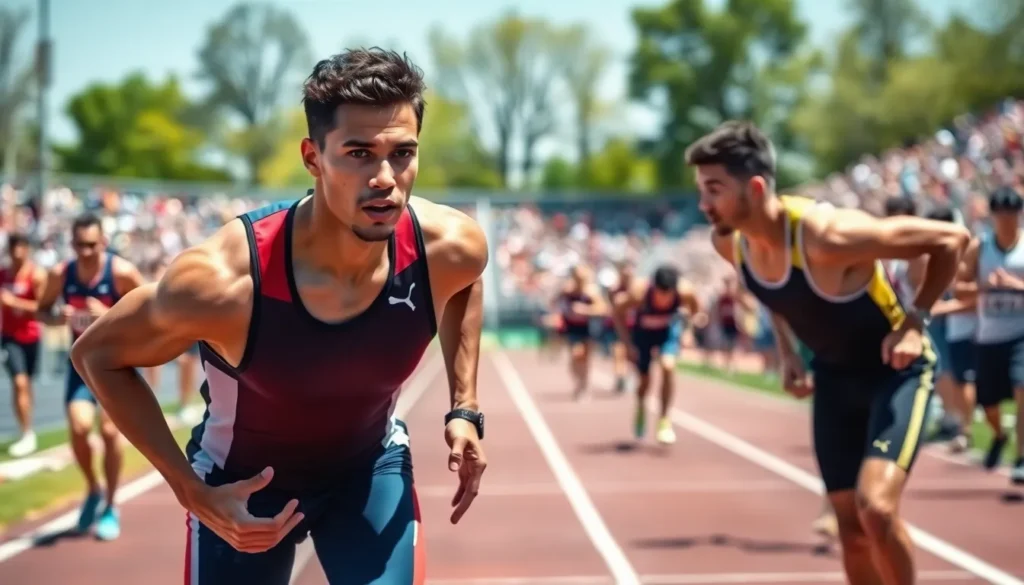Every runner knows the thrill of the race, but how many truly understand the art of pacing? Imagine sprinting out of the gate like a caffeinated cheetah only to hit the wall before the finish line. Ouch! Race pacing is the secret sauce that can turn a good race into a great one, ensuring runners don’t just survive but thrive.
Mastering race pacing isn’t just for elite athletes; it’s for anyone looking to crush their personal bests. It’s about finding that sweet spot where speed and endurance dance together in perfect harmony. So let’s dive into the world of race pacing strategies. With a little know-how, runners can transform their race day experience from a chaotic dash to a well-orchestrated symphony. After all, who wouldn’t want to cross the finish line feeling like a champion instead of a gasping fish out of water?
Table of Contents
ToggleUnderstanding Race Pacing Strategy
Race pacing involves planning the optimal speed throughout a race to achieve peak performance. Mastering pacing can enhance individual finish times and increase overall enjoyment during races.
Importance of Pacing in Races
Pacing directly affects a runner’s ability to sustain energy for the race’s duration. Starting too fast can lead to early fatigue, resulting in slower finishing times. Solid pacing allows a runner to maintain energy levels, improving overall performance. Research indicates that proper pacing strategies lead to better race outcomes and increased satisfaction. Emphasizing the importance of pacing encourages all runners to adopt a thoughtful approach, ensuring a rewarding experience.
Types of Pacing Strategies
Various pacing strategies cater to different race distances and runner preferences. Negative splits involve running the second half of the race faster than the first. This method often results in higher finishing speeds and minimized fatigue. Conversely, even pacing maintains consistent speeds throughout the event, promoting endurance. Another strategy, known as positive splits, entails running faster in the first half; this approach can backfire, jeopardizing the finish. Choosing the right pacing strategy greatly influences race performance and overall outcomes.
Factors Influencing Race Pacing Strategy

Race pacing strategy hinges on various influencing factors. Understanding these factors can enhance a runner’s performance.
Distance and Duration of the Race
Distance determines pacing strategy. Shorter races typically benefit from a faster pace, while longer events require a more conservative approach. A 5K might see runners starting strong and maintaining speed, while a marathon demands energy conservation for endurance. Tapering training distances helps runners gauge their optimal race pace. Different race lengths necessitate unique pacing techniques. Adapting pacing strategy based on distance ultimately leads to better placement and satisfaction.
Environmental Conditions
Environmental factors play a significant role in pacing strategy. Temperature and humidity impact overall performance, with heat often requiring slower paces to avoid fatigue. Wind resistance affects energy expenditure, making it wise for runners to adjust speeds accordingly. Terrain variances, such as hills and uneven surfaces, necessitate changes in pacing to maintain efficiency. Runners should also consider altitude; higher elevations can lead to reduced oxygen levels, influencing stamina. Adjusting pacing based on these conditions ensures optimal performance on race day.
Benefits of an Effective Race Pacing Strategy
Effective race pacing strategies significantly enhance a runner’s overall performance and endurance. Understanding these benefits can lead to more rewarding race experiences.
Improved Performance
Optimal pacing helps runners achieve personal bests. Research shows that maintaining a steady pace allows for efficient energy use, reducing fatigue during the race. Consistency in pacing contributes to better finishing times, especially in longer races. It allows athletes to push through the final miles with confidence rather than exhaustion. Runners often find that sticking to a planned strategy results in more controlled efforts, preventing burnout. Data indicates that athletes who employ proper pacing techniques perform better than those who do not.
Enhanced Endurance
Endurance improves with effective race pacing strategies. By regulating speed throughout the race, runners maximize their stamina, enabling longer and more intense efforts. Sustained energy levels prevent early fatigue, leading to stronger finishes. Training with pacing strategies reinforces muscle adaptation, helping runners withstand longer distances. According to studies, runners who pace themselves effectively report higher satisfaction levels post-race. This enhanced endurance allows for more enjoyable race experiences and can lead to more frequent personal records.
Common Mistakes in Race Pacing Strategy
Runners often face several pitfalls when it comes to race pacing strategy. Two common mistakes include starting too fast and ignoring personal limits.
Starting Too Fast
Starting too fast remains a frequent error among runners. This mistake often leads to early fatigue, diminishing performance in the latter stages of a race. Many athletes succumb to the adrenaline of the starting line, resulting in a pace that isn’t sustainable. Research indicates that those who start at a relaxed, manageable speed tend to maintain energy throughout the race, leading to better results. With the first few miles establishing the pace, it’s crucial to resist the urge to sprint. Instead, aiming for a consistent tempo from the get-go significantly improves finishing times.
Ignoring Personal Limits
Ignoring personal limits can also derail effective pacing. Each runner has unique strengths and weaknesses, influenced by factors like experience, fitness level, and race distance. Pushing beyond these limits often leads to burnout or injury. It’s essential for athletes to respect their individual capabilities and set realistic goals. Adapting pacing strategies to match personal thresholds fosters endurance and maintains energy levels, especially during challenging races. Tuning into one’s body signals helps runners stay within their limits, leading to a more enjoyable race experience.
Mastering race pacing strategy is essential for any runner aiming to improve performance and achieve personal bests. By understanding the nuances of pacing and adapting to various race conditions, athletes can enhance their endurance and overall satisfaction.
Implementing effective strategies not only leads to better race outcomes but also creates a more enjoyable experience.
Avoiding common pitfalls like starting too fast and respecting personal limits allows runners to maintain energy and finish strong. With the right approach to pacing, every runner can transform their race day into a triumphant celebration of their hard work and dedication.





